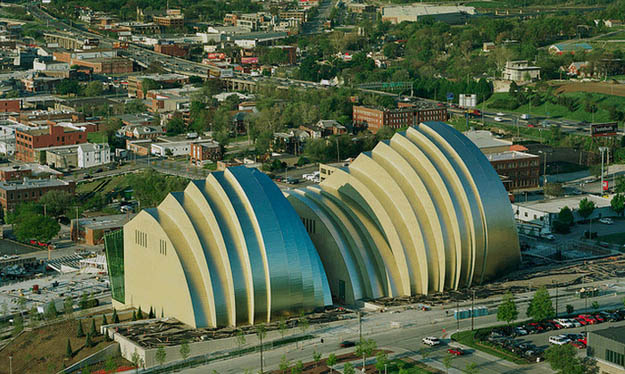Monash University announced this week that it’s commissioned famous international architect Moshe Safdie (this report calls him a ‘starchitect’) to design its new $80 million Sir Zelman Cowen School of Music at the entrance to the university’s Clayton campus.
Exhibit: Kauffman Centre, Kansas City, 2011, designed by Safdie Architects
The design concept for the 600 seat auditorium won’t be revealed publicly until 23 October. However the University released a picture of Safdie Architects’ recently-completed Kauffman Centre in Kansas City (see exhibit) as a guide, presumably, to what the Clayton building could look like.
Moshe Safdie is a very famous and talented architect. He’s the man who designed the ground-breaking housing complex in Montreal, Habitat 67, nearly 50 years ago.
Buildings completed by Safdie Architects in 2011 include Singapore’s Marina Bay Sands, Crystal Bridges Museum of American Art in Bentonville and Khalsa Heritage Centre in Punjab. The firm has designed auditoria before including the Kauffman Centre and Mercaz Shimshon in Jerusalem.
Iconic buildings have become part of the marketing arsenal of Australian universities. Back in March I discussed the new Frank Gehry-designed business school currently under construction at Sydney’s University of Technology.
It seems some universities are looking to glamorous architecture as a way of marketing their wares in a competitive international education environment. Traditional ways of differentiating their product – like the quality of courses, staff and research – apparently aren’t enough.
The ambience of the campus grounds, both natural and built, isn’t enough either. There have to be iconic, attention-grabbing buildings that send a strong message. The new building designed by Morphosis Architects for the Cooper Union in Manhattan is a classic example.
The Sir Zelman Cowen School of Music will be built on an existing car park at the main entrance to the university. Certainly there’s an argument that such a prominent position demands outstanding architecture.
An obvious question is why it’s necessary for Monash, or any university, to go overseas to get a suitable designer. Moshe Safdie will be working in association with local firm Fender Katsalidis, designers of the sublime Eureka Tower, but it’ll be his conception, not theirs.
One way of looking at this is to acknowledge it’s simply globalisation in action. Monash naturally want something really good and in the university’s opinion that requires they commission a famous and respected architect who’s located in Boston.
After all, the Sydney Opera House – arguably the world’s best contemporary building – was designed by a Dane. Moreover Australian architects themselves win plenty of commissions overseas, especially in Asia.
There’ll inevitably be some additional cost associated with using a high profile international firm. That’s partly because Safdie Architects are based overseas, partly because there’ll be a premium for the name, and partly because ‘starchitects’ can stretch the envelope further. But that’ll be repaid in the quality of the outcome.
An alternative way of looking at it, though, is to note that this is a relatively modest project that hardly warrants commissioning a big name international architect. It’s a smallish 600 seat auditorium with an all-up cost of $80 million.
That’s considerably less than the $136 million required for the refurbishment of Melbourne’s Hamer Hall by local firm ARM. And it’s a considerably smaller project than Melbourne’s new 1,000 seat Recital Centre, also designed by ARM.
There are Australian firms that are perfectly capable of designing this sort of building. I checked with a university project manager who immediately rattled off the names of six firms in Melbourne who could do this sort of project. Obviously there’d be more in other cities.
There are also quite a few who could produce the kind of iconic, glamorous “landmark” building Monash wants. Producing headline buildings is much more a function of opportunity than rare talent.
I think the key reason Monash has plumped for a ‘starchitect’ is because the project isn’t solely, or perhaps even primarily, conceived as a design task. Rather, it’s mainly a marketing exercise.
Fair enough, that’s Monash’s assessment of what it thinks is necessary in its industry to be competitive. I have some misgivings though about putting a lot of the weight of marketing on design i.e. ‘starchitecture’.
It can cost a lot, there’s a risk it won’t work as marketing, and the inevitable functional compromises are around for a long time. Good architecture and ‘starchitecture’ are not always the same thing. Good architecture comes from a process of optimisation, not iconisation.
Still, it’s the university’s call. So long as it invited a short list of suitable Australian architects to make submissions for this project and properly and objectively evaluated their claims, no one can complain.
Yet the curious thing is I can’t get a straight answer out of Monash about how it went about selecting and appointing Safdie Architects. Very curious. (Update: Is this the best way to appoint an architect?).








Crikey is committed to hosting lively discussions. Help us keep the conversation useful, interesting and welcoming. We aim to publish comments quickly in the interest of promoting robust conversation, but we’re a small team and we deploy filters to protect against legal risk. Occasionally your comment may be held up while we review, but we’re working as fast as we can to keep the conversation rolling.
The Crikey comment section is members-only content. Please subscribe to leave a comment.
The Crikey comment section is members-only content. Please login to leave a comment.